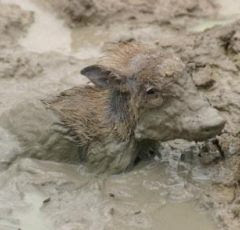The Mongol military tactics and organization enabled the Mongol Empire to conquer nearly all of continental Asia, the Middle East and most of eastern Europe. The Great Khans, starting with Genghis, also employed an egalitarian type of leadership that the world had never seen before. They led in battle from the front, they led in philosophy from the bottom-up. As they expanded their Empire into new areas, their troop numbers increased as other peoples were included in their conquests, such as during the battle of Baghdad, which included many diverse people fighting under Mongol leadership.
One of their greatest strengths was religious tolerance. Having been Pantheists, who see god equally in everything [flora, fauna, microbe, mineral, forces and faeries] for millennia, allowed them to see all religions as expressions of the same greater reality. Consequently shortly after their armies defeated Islam, annihilated Baghdad and killed the Caliph the Khans became so impressed by Islam's advanced mathematics, arts, language, engineering and spiritual devotion that their leaders including Genghis and especially Batu converted to Islam.
Even after adopting Islam the Mongols remained as tolerant as before and Batu Khan, Khan of the Golden Horde, who first became a Muslim, allowed the Rus' to found a Christian bishopric in his capital. Nogai Khan, half a century later, married a daughter of the Byzantine emperor, and gave his own daughter in marriage to a Rus' prince, Theodor the Black.
The original foundation of Great Khan's political and military system was an extension of the nomadic lifestyle of the Mongols. Other elements were invented by Genghis Khan, his generals, and his successors. Useful technologies were adapted from other cultures, and foreign technical experts integrated into the command structures.
Mongols at the Walls of Vladimir by Vasily Maksimov The Mongols outside Vladimir presumably demanding tribute or else...
Ögedei Khan was the second Great Khan, Genghis Khan was the 1st, Güyük Khan, Ögedei's oldest son was the 3rd [but ruled only 2 years]. Möngke Khan was 4th, another grandson of Genghis and the first Great Khan from the Toluid line. In his 8 years the Mongols conquered the rest of Iraq and Syria as well as the kingdom of Nanzhao [now Yunnnan in Southern China and parts of Vietnam, Laos, Burma and Tibet].
After Möngke's death in 1259 the long and famous reign of Kublai Khan, the 5th Great Khan, and yet another grandson of Genghis began. In 1279, Kublai completed the long war against the song Dynasty of the Han Chinese and established the Yuan Dynasty, which ruled over present-day Mongolia, China, Korea, and some adjacent areas, and assumed the role of Emperor of China. The summer garden of Kublai Khan at Xanadu is the subject of Samuel Taylor Coleridge's 1797 poem Kubla Khan. This poem and Marco Polo's earlier book brought Kublai and his achievements to the attention of a wider audience, and today Kublai is a well-known historical figure.
In about 1360 Tarmashirin Khan a Turko-Mongol ruler of Barlas lineage, historically known as Tamerlane, gained prominence. Tamerlane's Turco-Mongolian heritage provided opportunities and challenges as he sought to rule the Mongol Empire and the Muslim world. According to the Mongol traditions, Timur could not claim the title of Khan or rule the Mongol Empire because he was not a descendant of Genghis Khan. Likewise, Tamerlane could not claim the supreme title of the Islamic world, caliph, because that office was limited to the Quraysh, the tribe of the Prophet Muhammad.
Nonetheless Tamerlane ruled over an empire that, in modern times, extends from southeastern Turkey, Syria, Iraq, and Iran, through Central Asia encompassing part of Kazakhstan, Afghanistan, Armenia, Azerbaijan, Georgia, Turkmenistan, Uzbekistan, Kyrgyzstan, Pakistan, and even approaches Kashgar in China. Tamerlane's military talents were unique. His was not a nomadic army, he ruled from his famous palace in Samarkand at the key crossroads of the Silk Road. He planned all his campaigns years in advance, even planting barley for horse feed two years ahead of his campaigns. Tamerlane's descendants founded the Mughal Empire that ruled the Indian sub-continent for centuries.
The Mongol Empire conquered diverse cultures and in so doing untied them into the modern nations and Empires of modern Eurasian history. In their path they spread not only religious tolerance but multiculturalism, literacy, science and technology, military innovation and a philosophy based on their rural pastoral roots and respect for every living thing, along with their brutal response to those who refused to pay tribute.
The Mongols united China, India, Russia and many others into the modern states they are through tolerance and innovation.as well as conquest




